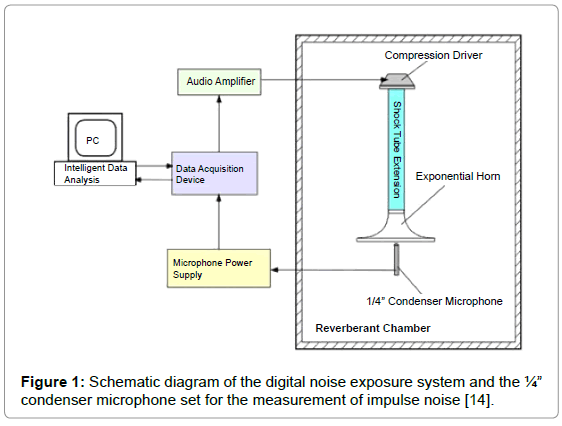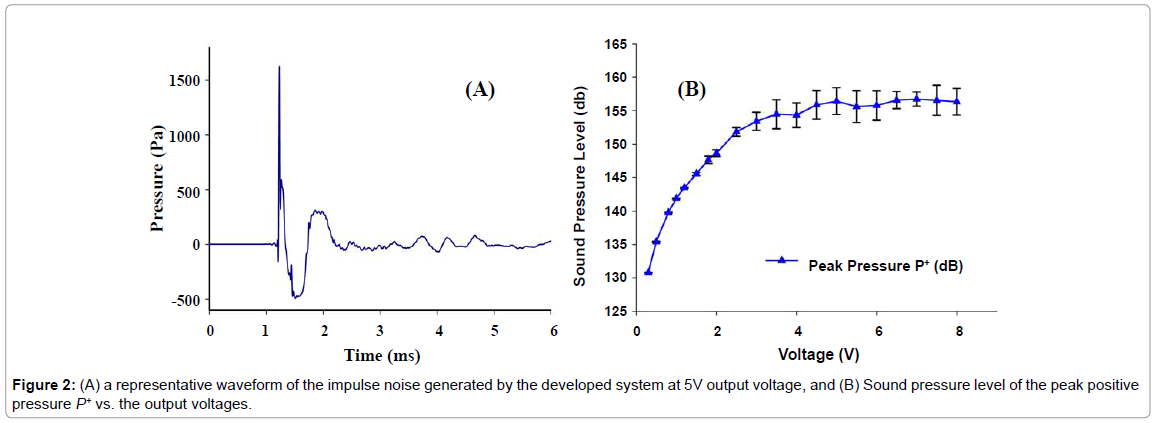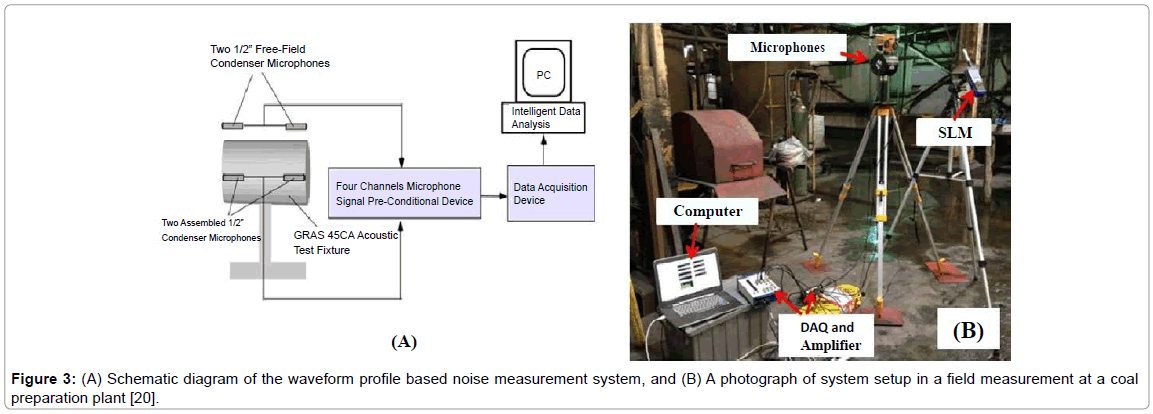Editorial Open Access
Recent Developments on Noise Induced Hearing Loss for Military and Industrial Applications
Jun Qin1*, Yuhao Jiang2 and Ali Mahdi1
1Department of Electrical and Computer Engineering, Southern Illinois University, Carbondale, IL 62901, USA
2Department of Engineering and Physics, University of Central Oklahoma, Edmond, OK 73034, USA
- Corresponding Author:
- Jun Qin
Department of Electrical and Computer Engineering
Southern Illinois University
Carbondale, IL 62901, USA
Tel: (618)453-3460
E-mail: jqin@siu.edu
Received October 16, 2014; Accepted October 16, 2014; Published October 21, 2014
Citation: Qin J, Jiang Y, Mahdi A (2014) Recent Developments on Noise Induced Hearing Loss for Military and Industrial Applications. Biosens J 3:e101. doi:
Copyright: © 2014 Qin J, et al. This is an open-access article distributed under the terms of the Creative Commons Attribution License, which permits unrestricted use, distribution, and reproduction in any medium, provided the original author and source are credited.
Visit for more related articles at Biosensors Journal
Abstract
Noise induced hearing loss (NIHL) is a problem that affects many people throughout the world. According to the World Health Organization (WHO), exposure to excessive noise is the major avoidable cause of permanent hearing loss worldwide. In the United States, NIHL is one of most common occupational related diseases. It is estimated that 16.1% of adults or about 29 million Americans have some type of hearing loss within the speech frequency range. This number seems to be on the rise since about 30 million Americans are currently exposed to noise every day in their jobs. Hearing loss has been shown to lower the quality of life, impair social interactions, cause isolation, and can cause loss of cognitive function
Introduction
Noise induced hearing loss (NIHL) is a problem that affects many people throughout the world. According to the World Health Organization (WHO), exposure to excessive noise is the major avoidable cause of permanent hearing loss worldwide [1]. In the United States, NIHL is one of most common occupational related diseases. It is estimated that 16.1% of adults or about 29 million Americans have some type of hearing loss within the speech frequency range [2]. This number seems to be on the rise since about 30 million Americans are currently exposed to noise every day in their jobs [3]. Hearing loss has been shown to lower the quality of life, impair social interactions, cause isolation, and can cause loss of cognitive function [3].
Noise can be classified into continuous Gaussian noise (i.e., steady state noise), high-level impulsive noise (including impulse noise and impact noise), and complex noise (i.e., a non-Gaussian noise consisting of impulsive noise mixed with a Gaussian noise) [4,5]. All types of noise at high noise intensity levels could cause hearing loss. However, a number of studies showed that the complex noise produced much higher hearing loss than an energy-equivalent continuous or impulsive noise alone in animal experiments [4,6-8]. Epidemiologic studies have demonstrated an increased incidence of hearing loss in industries with complex noise environments [6,9,10]. Most noise exposures in the military and industrial fields are subjected to high-level complex noise.
Although significant progress has been made, NIHL still remains as a severe problem in various industrial and military fields. Specifically, research and investigation on high-level non-Gaussian noise induced hearing loss are still needed. In this study, we will introduce two recently developed research projects on NIHL. One project is focusing on the investigation of impulse noise induced hearing loss for military application, and the other project focuses on the development of a new noise measurement system for the complex noise in industrial fields.
Research on Impulse Noise Induced Hearing Loss
Impulse noise refers to the nonreverberant A-duration wave, and it is a type of highly transient noise widely experienced in military field [11]. Impulse noises can be produced by firearms, rockets, hammering, etc. [12]. It has been demonstrated that the impulse noise could cause more hearing loss than continuous noise with same amount of acoustic energy in animal studies [13]. Impulse noise induced hearing loss remains as a severe health problem in military and industrial fields.
Noise exposure system for generating impulse noise
A new digital noise exposure system has been developed to generate impulse noise [14,15]. The system can successfully generate impulse noise with peak sound pressure level (SPL) up to 160 dB, which effectively mimics the noise produced by a military weapon (e.g., M-16 rifle). As shown in Figure 1, the noise exposure system consists of a data acquisition device (NI DAQUSB-6251), an audio power amplifier (Yamaha P2500S), an acoustic compression driver (JBL 2446J), a shock tube extension (3’ length and 2” diameter), an exponential horn (JBL 2380), and a computer. A user interface was created using LabVIEW software to generate digital noise signals and control the system. The system was installed in a reverberant chamber.
The Friedlander wave has been used to simulate the A-duration impulse noise. It can be described by the equation.
 (1)
(1)
where Ps is the peak sound pressure, and the t* is the time at which the pressure crosses the x-axis and goes from positive to negative. The digital signals of impulse noise were generated using the Friedlander equation in LabVIEW, and then converted to analog signals with 62.5 kHz sampling rate. The analog signals were amplified by the audio power amplifier, and fed into the compression driver to generate impulse noise.
Measurements and characterization of generated impulse noise
To measure the impulse noise generated by the developed system, a ¼” high sensitivity condenser microphone set (GRAS 46BF) was used. The measured signals were converted into digitals signal through the data acquisition device with 125 KHz sampling rate and saved in the computer (Figure 1). The microphone was aligned at the center of the outlet of the horn. The impulse noise signals were generated at different output voltages (from 0.3 V to 8 V).
Figure 2A shows the time history of a representative waveform of impulse noise generated by the developed noise exposure system at 6.0 V. The waveform is leading by a compressive waveform segment with ~ 0.3 ms duration, followed by a rarefaction waveform segment with ~ 0.6 ms duration, and ending with a oscillation tails with about 5 ms duration. The waveform was generated to mimic the impulse noise produced by a M-16 rifle, and it is comparable with the waveform of impulse noise measured in military fields [16].
Figure 2B shows the SPL of peak positive pressure P+ of impulse noise at different output voltages. The P+ increases, from 130 dB to 160 dB, with the output voltage increasing, and it is saturated when the output voltages greater than 4 V.
In summary, a novel digital noise exposure system has been developed to study impulse noise induced hearing loss in an animal model. The impulse noise can be successfully generated by the developed system to mimic the noise produced by a military weapon (e.g., M-16 rifle). The max peak SPL of the impulse noise can reach to 160 dB. The system replicates environmental noise, and it allows researchers to study impulse noise induced hearing loss in a controlled situation.
A Complex Noise Measurement System for Industrial Applications
Noise exposure in many workplaces is subjected to the complex noise. The current noise measurement guidelines in the standards (e.g., ISO-1999, 1990, ANSI S3.44-1996, MIL-STD-147 D, 1997) are developed based on the equal energy hypothesis (EEH), which states that NIHL mainly depends on the total acoustic energy of noise exposure [17,18]. In addition, conventional sound level meters (SLMs) which are also designed based on the EEH. However, previous studies showed that the EEH could not accurately rate the complex noise [5,18]. Therefore, the conventional SLMs may not suitable to be used for the assessment the complex noise often experienced in high-noise industrial fields [19].
Waveform profile based noise measurement system
A waveform profile based noise measurement system has been developed for more accurate assessment of complex noise in industrial fields [20]. As shown in Figure 2A, the system consists of an acoustic test fixture (GRAS 45CA) with two ½-inch pressure condenser microphones assembled, two ½-inch free-field condenser microphones, a 4-channel microphone signal conditioning amplifier, a data acquisition device (NIDAQ USB6254), and a laptop. The test fixture is used to emulate the structures of human head and ear canals. Two assembled ½-inch pressure microphones are used to record acoustical pressure waveforms in the ear cannel, while the other two ½-inch free-field microphones are used to record the pressure waveforms in free field.
After the development, the noise measurement system was validated by compared with a conventional SLM using various noise signals, including pure tone noise, Gaussian noise, and complex noise in the lab. The noise signals were simultaneously measured by the develop system and the SLM. The validation results indicate that the developed system is comparable with the SLM when measuring the time averaged SPLs.
Pilot field noise measurements
Field measurements have been conducted using the developed noise measurement system in a coal preparation plant. Figure 3B shows the setup of the developed system in a field measurement. In each field measurement, a conventional SLM was used for a quick SPL measurement at different locations in the plant. Three locations were selected for the comprehensive measurement using the developed system, which are Level 1 nearby the entrance of the plants as background noise measurement, Level 3½ nearby the screen bowl as the highest averaged SPL location, and Level 4 nearby the DR screen at the highest peak SPL location. At each selected location, twenty noise signals (5 minutes time duration) were measured and recorded by the developed system for further signal analysis.
Characterization of complex noise measured in the field
In this study, the noise metrics have been used to evaluate the complex noise measured in the field, which include A-weighted equivalent SPL LAeq, C-weighted equivalent SPL LCeq, and the peak SPL Lpmax.
The equivalent SPL Leq can be defined as [21]:
 (2)
(2)
where p0 is the reference pressure level 20uPa. PA is the acquired sound pressure in Pa. The time period for data samples ranges from t1 to t2. When applying the A-weighted and C-weighted filters to the acoustic signals, equivalent SPL are described as LAeq and LCeq, respectively.
The LAeq, LCeq, and Lpmax of the complex noise measured by the developed system at three locations in the field are summarized in Table 1. At all three locations, the C-weighted SPLs LCeq are about 10 dB higher than the A-weighted SPLs LAeq.
| Locations | LAeq, dB | LCeq, dB | Lpmax, dB |
|---|---|---|---|
| Level 1 | 92.25 | 105.24 | 114.40 |
| Level 3½ | 99.79 | 108.34 | 118.58 |
| Level 4 | 95.13 | 115.07 | 122.97 |
Table 1: Summary of different noise levels measured at three locations in the field.
In addition, Figure 4 shows a representative waveform (5 second time duration) and amplitude spectrum of a noise signal measured in the field. It shows that the noise signal measured in the field is a complex noise (Non-Gaussian noise). In the amplitude spectrum (Figure 4B), higher amplitudes can be found at low frequency range (< 100Hz). It indicates that the complex noise measured in the field contents very strong low frequency components. Such low frequency components are not counted into the LAeq due to the frequency response of an A-weighted filter. While these low frequency components are included in the calculation of LCeq. This is the main reason that causes 10 dB difference between LCeq and LAeq summarized in Table 1. The LAeq is the metric currently used in government regulation for assessment of the complex noise in mining fields. It is generally considered appropriate for continuous Gaussian noise but not for complex noise. Such criteria may significantly underestimate the risk of high level complex noise in industrial fields.
In summary, we developed new noise measurement system for the investigation of the complex noise in coal mining fields. The developed system not only can measure the noise levels, but also can record detailed waveform of complex noise signals in fields. The system has been successfully validated both in the lab and in a high-noise industrial field. The preliminary results demonstrated that the developed noise measurement system can be used to accurately evaluate the risks of high level complex noise in industrial fields.
Conclusion
NIHL still remains as one of the most common occupational diseases in the United States. Research and investigation on NIHL is still needed in various applications. In this paper, we introduced two recent developments of impulse noise generation and complex noise measurements for different applications. In the first project, the developed noise exposure system can also generate different types of noises. The system can be used to mimic various environmental noises, and it allows researchers to study NIHL in a controlled situation. In another project, the developed noise measurement system focuses on waveforms of noise signals rather than the EEH based energy metrics. Such technology can provide detailed information of a complex noise, and it may lead to the development of new noise metrics. In our future work, a new metric evaluating system will be established, and more field measurements will conducted in different coal mining fields.
Acknowledgements
This research was supported in part by the Illinois Clean Coal Institute with funds made available by the State of Illinois.
References
- Smith G (1996) Noise? What noise? Occupational health & safety 65: 38.
- Agrawal Y, EA Platz, J.K. Niparko (2008) Prevalence of hearing loss and differences bydemographic characteristics among US adults - Data from the National Health and Nutrition Examination Survey,1999-2004. Arch Intern Med168:1522-1530.
- Daniel E (2007) Noise and hearing loss: A review.J Sch Health 77: 225-231.
- Hamernik RP, Qiu W, Davis B (2003)The effects of the amplitude distribution of equalenergy exposures on noise-induced hearing loss: The kurtosis metric.J AcoustSoc Am 114: 386-395.
- Hamernik RP, Qiu W, Davis B (2007)Hearing loss from interrupted, intermittent, and timevarying non-Gaussian noise exposure: The applicability of the equal energy hypothesis. J AcoustSoc Am122: 2245-2254.
- Qiu W, DavisB, Hamernik RP (2007)Hearing loss from interrupted, intermittent, and timevarying Gaussian noise, exposures: The applicability of the equal energy hypothesis.J AcoustSoc Am 121: 1613-1620.
- Qiu W, Hamernik RP, Davis B (2006)The kurtosis metric as an adjunct to energy in theprediction of trauma from continuous, nonGaussian noise exposures. J AcoustSoc Am 120: 3901-3906.
- Davis RI, Qiu W, HamernikRP (2009)Role of the Kurtosis Statistic in Evaluating ComplexNoise Exposures for the Protection of Hearing. Ear Hear30: 628-634.
- LatayeR, Campo P (1996)Applicability of the L(eq) as a damage-risk criterion: An animalexperiment.J AcoustSoc Am 99: 1621-1632.
- Onder M, Onder S,Mutlu A (2012)Determination of noise induced hearing loss in mining:an application of hierarchical loglinear modeling. Environ Monit Assess184: 2443-2451.
- Henderson D,Hamernik RP (1986) Impulse noise: critical review.J AcoustSoc Am 80: 569-584
- Birch RS, Vergara EF, Gerges S (2009) High-amplitude impulse noise: Measurement ofhearing protector attenuation using a shock tube. Noise Control Engineering Journal57: 585-594.
- Hamernik RP (1993)Audiometric and histological differences between the effects ofcontinuous and impulse noise exposures J AcoustSoc Am 93:2088-2095
- Qin J(2014) Development of a Digital Noise Exposure System for Research on NoiseInduced Hearing Loss. in Proceedings of the 167th meeting of the Acoustical Society of America. Providence, RI.
- Wu Q, Qin J (2013) Effects of key parameters of impulse noise on prediction of the auditoryhazard using AHAAH model.IntJComputBio Drug Design6: 210-220.
- Price GR (2007)Validation of the auditory hazard assessment algorithm for the human withimpulse noise data.J AcoustSoc Am 122: 2786-2802.
- Zhu X (2009) Development of a noise metric for assessment of exposure risk to complexnoises.J AcoustSoc Am 126: 703-712.
- Ahroon WA, Hamernik RP, Davis RI (1993) Complex Noise Exposures - AnEnergy Analysis. J AcoustSoc Am 93: 997-1006.
- Kardous CA, Willson RD (2004)Limitations of using dosimeters in impulse noiseenvironments.J Occup Environ Hyg1: 456-462.
- Qin J, Sun P,Walker J (2014) Measurement of Field Complex Noise Using a Novel AcousticDetection System.in Proceedings of IEEE AUTOTEST 2014. St. Louis, MO.
- ISO 1999: 1990(1990) Acoustics - Determination of Occupational Noise Exposure and Estimation ofNoise-Induced Hearing Impairment.IntOrgStandSwitzerland.
Relevant Topics
- Amperometric Biosensors
- Biomedical Sensor
- Bioreceptors
- Biosensors Application
- Biosensors Companies and Market Analysis
- Biotransducer
- Chemical Sensors
- Colorimetric Biosensors
- DNA Biosensors
- Electrochemical Biosensors
- Glucose Biosensors
- Graphene Biosensors
- Imaging Sensors
- Microbial Biosensors
- Nucleic Acid Interactions
- Optical Biosensor
- Piezo Electric Sensor
- Potentiometric Biosensors
- Surface Attachment of the Biological Elements
- Surface Plasmon Resonance
- Transducers
Recommended Journals
Article Tools
Article Usage
- Total views: 16003
- [From(publication date):
December-2014 - Apr 02, 2025] - Breakdown by view type
- HTML page views : 11318
- PDF downloads : 4685




